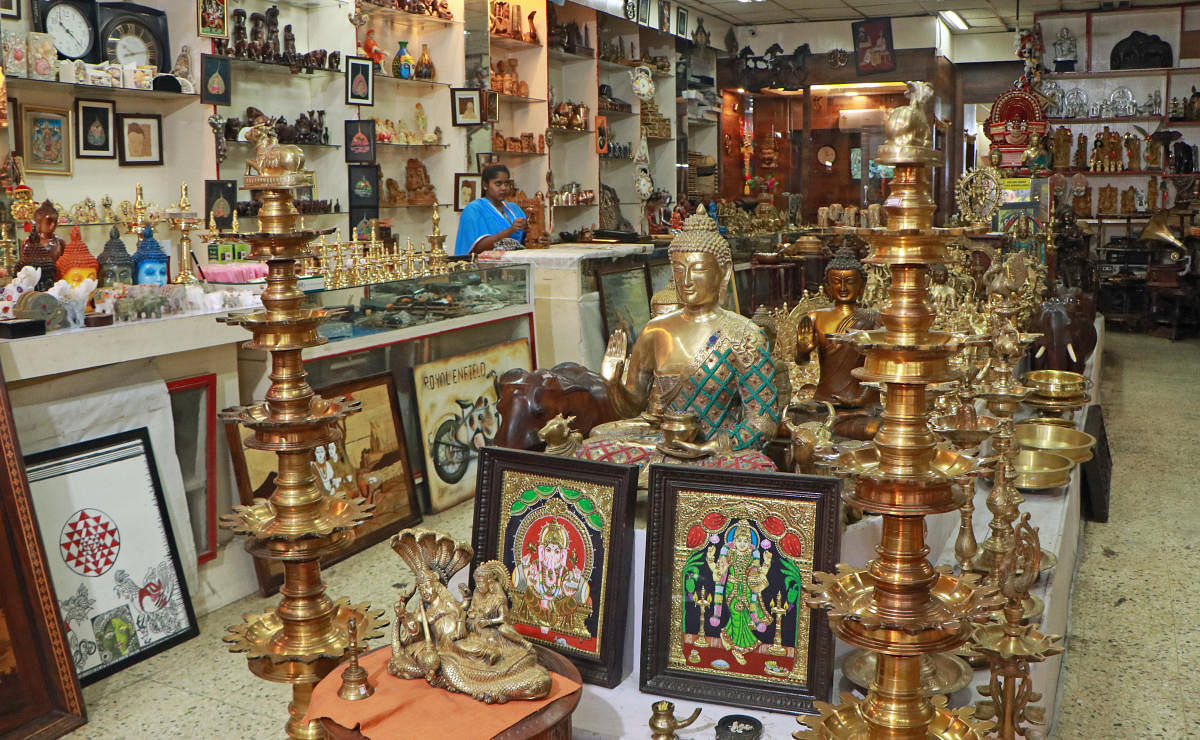
November to January is peak business time for government-run emporiums in the city but sales have been slow so far, say owners.
While they have reached 20% to 50% of pre-pandemic levels and are employing fewer staff to keep costs low, the owners fear that the impending recession, and the lack of artisans may dash the hopes of recovery they have from the current holiday season.
Metrolife visited the emporiums located in the Public Utility Building, often referred to as ‘the handicrafts hub of Bengaluru’, and others on M G Road.
“Business had picked up slowly in the past few months but it crashed in November. Could it be because of the recession?” wonders Ramachandran, franchisee owner of Kerala State Handicrafts Emporium.
Handicrafts are not an essential item. They come last on the list of priorities, many reason why turmoil in the job market hurts them immediately.
Moreover, a declining interest in handmade products is an ongoing worry. While Ramachandran’s handicrafts business dipped since 2020, sales at his vinyl shop shot up “as people found time to put their old record players to use during the pandemic”, he says.
Rajesh Jain, owner of Rajasthan Emporium and Handicrafts, is offering a permanent 30% discount to encourage footfall. “Earlier, we would give discounts only during festivals.”
If the handicrafts business doesn’t pick up soon, he plans to shut it down and focus on selling gemstones for therapy, wearing, and astrological purposes, a segment he had added to his inventory soon after the Covid outbreak. “It is selling pretty well,” he says.
As orders shrunk during the pandemic, many generational artisans took up other jobs for sustenance. “Artisans who do specialised needlework are important to our textile segment. We are barely left with 10 to 12% of them,” says Rajesh.
Similarly, Tabrez Jhan, the young owner of Kashmir Cottage Emporium, says, “Carpets are our top-selling item. Compared to 1982 when my family started this shop, we have half as few artisans who make carpets by hand. Most are in their 50s and above, and youngsters are not continuing the tradition.” And so, he has stocked some machine-made carpets now.
According to an official at Karnataka government’s Cauvery Arts & Crafts Emporium, they are struggling to meet customer demand because of the scarcity of artisans.
They made sales of more than Rs 2 crore in April, Rs 3 crore in May, and Rs 4 crore in June. November sales stand around Rs 1.7 crore so far, he shared. Their sandalwood items, incense sticks and furniture are the most sought-after. To close the gap, the Karnataka State Handicrafts Development Corporation is running Gurukula at Sagar in Shivamogga district. Students, with an SSLC degree and more, are taught wood and stone carving by master craftspersons, he informed.
Change in purchase patterns
Emporiums are a popular stop for foreign tourists and Indians visiting from other countries and Indian cities. They come to buy handmade artefacts, clothes and souvenirs.
An absence of these visitors during the Covid period sprung up a new clientele — “local Indians”.
“It’s been a surprise,” Showkath Ahmad, owner of Kashmir Carpets Cottage Industries Emporium, admits. Before the pandemic, his clientele comprised long-time customers, and IT companies who would buy gifts for foreign delegates.
He explains the shift: “As people stayed home during the lockdowns, they started paying attention to home decor and bought carpets. The purchasing power was not an issue as a few IT professionals were getting higher salary (as tech jobs were in high demand).”
Javeed Saleem Mir, the owner of Miracle Cottage Industries Emporium, concurs: “Earlier the ratio of foreign to local Indian customers was 70:30. Now, it is 20:80.”
There has been a shift in the purchase value too and not a favourable one. Javeed says, “Where foreigners would buy an item worth Rs 1 or 3 lakh, Indians are spending Rs 2,000 or Rs 3,000 per purchase.”
Buyers bargain a lot more now. Tabrez says, “Earlier, foreigners would pay the price we quote right away. Now, they also bargain.”
This is worrisome since walk-ins are fewer. A number of reasons are cited: Some are still working from their hometowns and others don’t feel like stepping out of their homes now. Handicrafts are available online. The lack of parking on M G Road is a constant grouse, and the metro construction has cut off the influx of shoppers from Commercial Street to M G Road.
Not just government-run emporiums but even private shops are struggling. “In 2016, companies used to order 1,000 gifts. It is down to 30-40 pieces,” says S Reshi of Sheriton’s Museum. He is stocking cheaper shawls to attract mid-segment buyers.